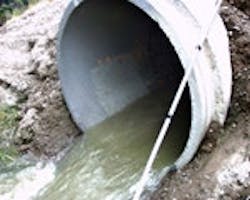About the author: Carlton Ray is deputy director of engineering for the Indianapolis Department of Public Works. He can be reached at 317/327-4000.
The city of Indianapolis is embarking upon the largest investment in clean water infrastructure in its history, creating opportunities for new business in one of America’s most affordable and entrepreneurial cities.
Mayor Bart Peterson’s Clean Streams-Healthy Neighborhoods program is an investment of more than $3 billion over 20 years. This program will address longstanding and well-documented problems within the city’s sewage and storm water systems. The initiative includes a $435 million capital program from 2006 through 2008 alone.
The city is addressing prioritized needs in four areas: reducing combined sewage overflows (CSOs), converting 18,000 homes on septic tanks to sewers, addressing current and future needs in the sanitary sewer system and improving neighborhood drainage and flood protection.
“The scope and size of this program is unprecedented in our community,” said Kumar Menon, director of the Indianapolis Department of Public Works. “Both residents and the business community are excited about this opportunity for healthier neighborhoods, cleaner streams and economic development.”
The program includes a required $1.8 billion investment under a federal consent decree signed in October 2006. Under the decree, the city has agreed to invest:
- $1.73 billion by December 2025 to significantly reduce CSOs;
- $50.4 million by December 2015 to eliminate chronic overflows from seven locations in the separate, sanitary sewer system; and
- $3.5 million by December 2010 on supplemental environmental projects to eliminate septic systems in two neighborhoods.
The city also plans to spend an additional $64.3 million in watershed improvement projects such as streambank restoration and streamflow augmentation.
“We cannot do this work alone,” Menon said. “With the commitment the city has made, we need to continue our efforts to cultivate business—engineers, contractors, consultants and others—who can help us execute the program on time.”
Experts needed
To effectively implement the program, expertise in the areas of pipelines, concrete, instrumentation and controls, hauling and excavation will be needed.
In addition, material suppliers for stone, asphalt and concrete as well as other support services such as traffic control, surveying and inspections services, are needed, Menon said.
The consent decree represents just a portion of the city’s capital improvement program, which also includes a comprehensive septic tank elimination program, sanitary sewer master plan and storm water master plan. By 2025, the city estimates that these programs will require a combined installation of:
- More than 25 miles of new sewers and interceptors to capture and reduce CSOs;
- A new 9-mile-deep underground tunnel to capture and convey CSOs to the city’s treatment plants;
- 300 miles of new sewers to serve current septic tank neighborhoods;
- More than 70 miles of new sewers and interceptors to meet sanitary sewer capacity needs and anticipated future growth; and
- Multiple storm water drainage projects and best management practices to improve storm water quality.
In addition, the city is implementing an aggressive sewer rehabilitation program that has helped extend the life of existing sewers and prevent hundreds of system failures. Most large diameter pipes in the combined sewer area are more than 100 years old, yet materials used for these pipelines generally have a 50-year lifespan. The rehab program has been able to extend expected life spans significantly.
“Since the 1990s, we have issued contracts for more than 90 sewer evaluation and rehabilitation projects worth more than $71 million,” Menon said. “These projects range from large-diameter pipes of 48 to 156 in. down to small 8 to 10 in. diameters, along with significant manhole rehab work.”
Infrastructure assessment
An infrastructure assessment completed in 1998 identified nearly 35,000 linear ft of large diameter sewer needing rehabilitation. Rehab or replacement is also needed for many of the city’s small diameter sewers, with 90% of the city’s underground sanitary sewer infrastructure 8 to 15 in. in diameter, Menon said.
“The demand for engineering, construction and ancillary services is expected to grow significantly with the implementation of the program,” said Jim Garrard, the city’s economic development director and former DPW director. “Indianapolis is a great place to live, with an attractive business climate and a long-term commitment to carry out this infrastructure improvement program.”
Like most older cities, sewer infrastructure in many neighborhoods has begun to reach the end of its useful life and must be repaired or replaced. All these factors have combined to make improving the sewer system a priority for the city of Indianapolis and Mayor Peterson.
The Peterson Plan in 1999 pledged to finally address the sewer overflow and septic system issues and move Indianapolis into the 21st century. Since then, the city has made steady progress in improving water quality, investing more than $200 million in early action projects to reduce sewer overflows.
The pace of improvements will continue to increase, with sanitary capital investments reaching more than $170 million annually in 2008 and 2009, and storm water capital approaching $8 million per year.
Download: Here
